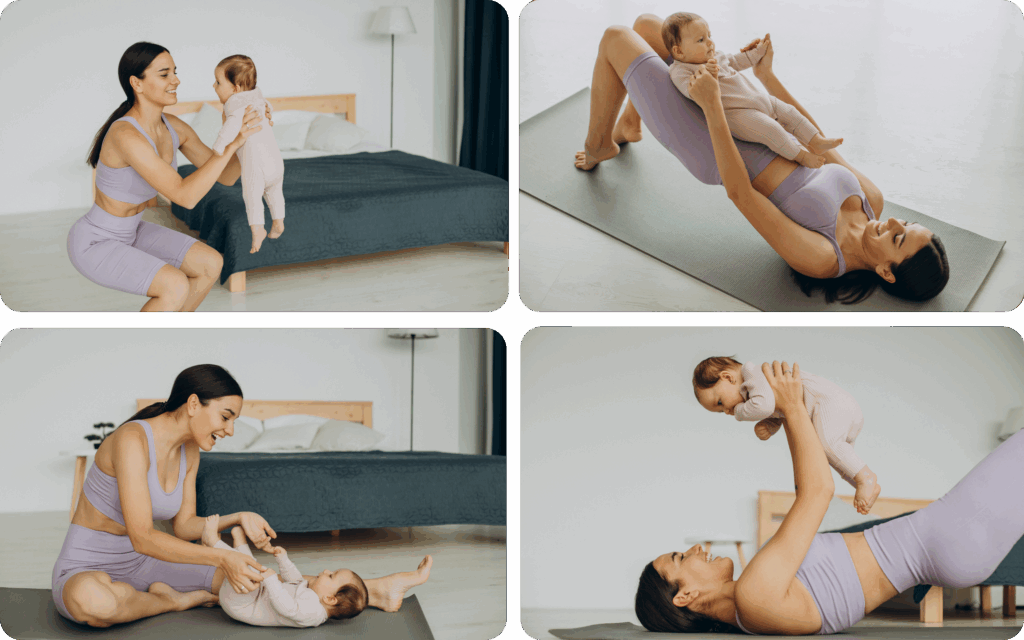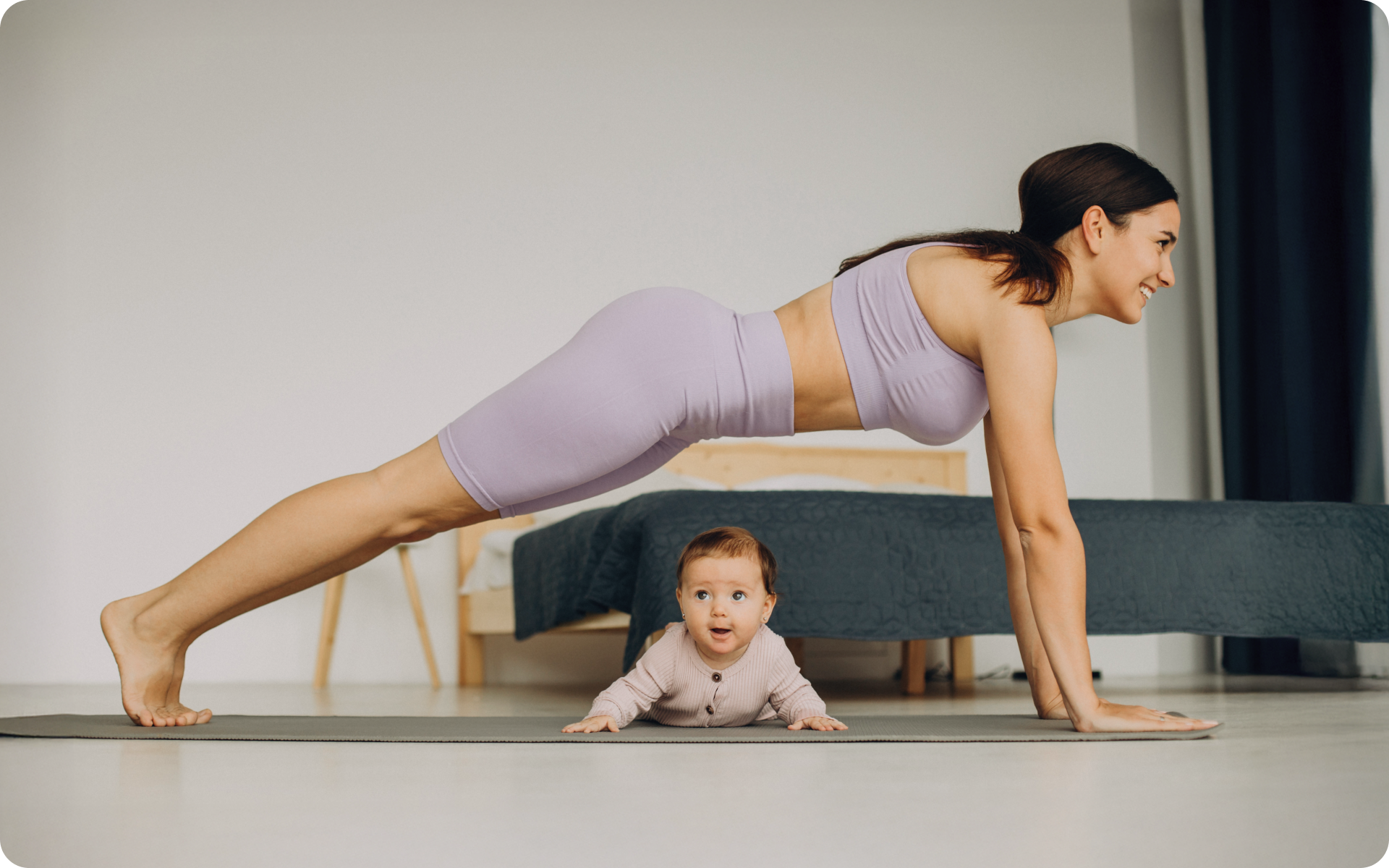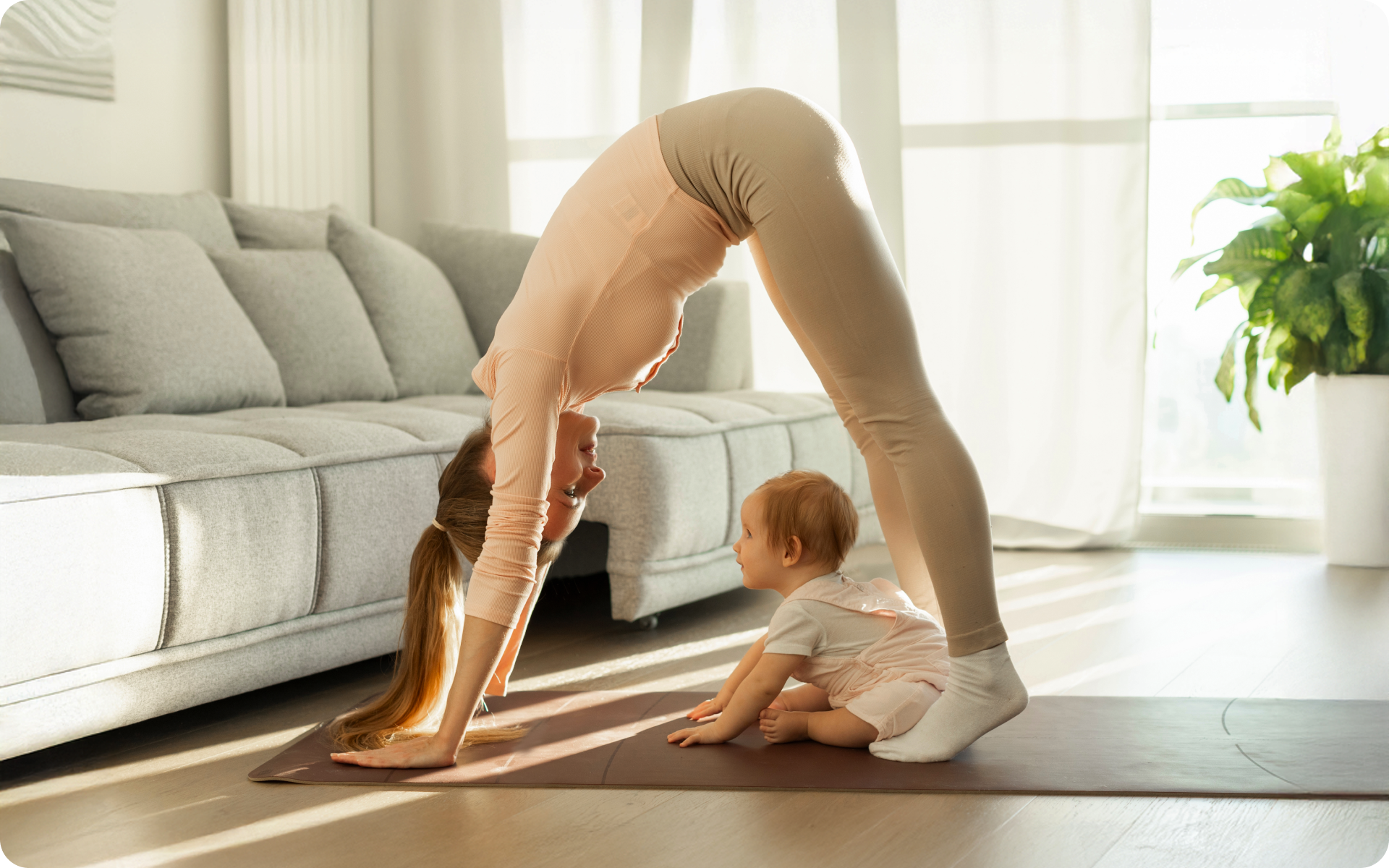Your body has just done something extraordinary – bringing new life into the world! And while your heart might be fuller than ever, your body probably feels a little unfamiliar right now. Among the many changes that come with this new chapter, it’s completely natural to want to feel stronger and more confident in your skin again. One of the most empowering ways to do that is by gently easing back into movement, starting with something as simple and doable as a postpartum arm workout.
The idea isn’t to “bounce back” overnight (because, let’s be real, there’s no bouncing back when you’ve been through something this transformative). Instead, it’s about reclaiming your strength, one rep at a time. And here’s the good news – your arms are a great place to start. Not only do strong arms help with the everyday lifting, cuddling, and carrying that comes with a newborn, but they also make you feel powerful, from inside and out.
In our guide, we’ll take you through gentle, effective, and totally doable ways to work those arms after pregnancy. No stress, no pressure, just support. Let’s take that first step together, and remember, you should always consult your physician before starting any recovery fitness program to ensure it’s suitable for your specific needs.
What Is a Quick Postpartum Arm Workout?
A quick postpartum arm workout is a short, gentle exercise routine that is designed to help new mothers gently regain strength and mobility in their arms after childbirth. These workouts usually last between 10 and 20 minutes, which makes them easy to fit into a busy day, especially when you’re navigating sleepless nights, endless diaper changes, and feeding schedules.
So why 10 to 20 minutes? Most postpartum fitness experts and health organizations recommend starting small and gradually increasing your activity. A study published in the International Journal of Environmental Research and Public Health included postpartum exercise sessions lasting around 20-25 minutes, which focused on low-intensity upper- and lower-body movements (including arms) using bodyweight and light weights (1).
In many real-life workout programs and videos for new moms, arm-focused sessions are even shorter, often around 10 to 15 minutes which is both practical and gentle in the early weeks of recovery.
Research has also shown that starting with short, functional workouts that are gentle on your recovery body. Many postpartum recovery programs include upper-body exercises as part of their structure, particularly after the 6-week mark, and often recommend light intensity and low resistance to start (2).
A typical quick postpartum arm workout might include:
- Gentle mobility movements, such as shoulder rolls or light stretches, to warm up and loosen tight muscles (3).
- Bodyweight exercises such as wall push-ups or arm circles to activate your upper body without straining your core (4).
- Light resistance training, using small dumbbells, resistance bands, or even common household items such as water bottles (5).
- Slow and controlled reps, with special attention on posture, breathing, and form instead of speed or volume (6).
The goal here isn’t to “go hard” or break into a sweat. It’s about reintroducing movement in a way that feels good, supports your recovery, and boosts energy without placing stress on sensitive areas like your core or pelvic floor.
You can do a postpartum arm workout at home, in comfortable clothes, while the baby naps or even with your newborn nearby. It’s simple, empowering, and one of the gentlest ways to reconnect with your body during recovery.
Read more: 10+ Postpartum Pilates Exercises for New Moms to Do at Home
Can You Do Arm Workouts After Giving Birth?
Yes, you can do arm workouts after giving birth, but when and how you start really depends on how your body is recovering. Most healthcare guidelines suggest that gentle physical activity (such as walking and light strength work) can be gradually reintroduced after your postpartum check-up, which typically happens around six weeks postpartum (6).
Although arm workouts don’t directly stress your pelvic floor like some core or lower-body exercises do, they still require proper posture, breathing, and muscle engagement. If you’ve had a vaginal delivery without complications, simple arm movements may feel okay earlier. But if you had a cesarean birth or experienced complications, your recovery will likely need more time.
You shouldn’t start with heavy lifting or intense strength training right away. The connective tissues, joints, and ligaments are still affected by hormonal shifts, particularly the presence of relaxin, which can last for several months.
What’s generally appropriate to begin with?
- Seated or standing arm mobility drills such as shoulder rolls, elbow circles, or overhead reaches
- Wall push-ups or biceps curls with light resistance (under 5 lbs to start)
- Resistance band pulls – which provide gentle tension without needing heavy weights
- Breathwork during movement, to support the core and stabilize your back
It’s also important to avoid holding your breath during movements. This can increase internal pressure and strain your recovering core and pelvic region. Don’t ignore your body’s signals. If you feel discomfort, heaviness, or tiredness, stop and rest.
Arm workouts can be a beautiful re‑entry point to fitness, but like all things postpartum, patience is your best friend.
Whether you’re a workout beast or just a beginner making your first foray into the world of fitness and dieting – BetterMe has a lot to offer to both newbies and experts! Install the app and experience the versatility first-hand!
How to Tone Your Arms After Pregnancy
If your goal is to feel stronger and more toned in your arms after pregnancy, the focus should be on healthy, sustainable habits that support your whole body. Spot reduction (such as focusing only on arm fat) isn’t backed by science, but a balanced approach combining nutrition, full-body movement, and strength training can help tone and define your arms over time.
Hormonal shifts, breastfeeding demands, sleep loss, and emotional stress all influence how your body adjusts postpartum (7, 8). That’s why compassion and consistency matter just as much as reps and sets.
Here’s what can help over time:
- Incorporate resistance training, including a postpartum arm workout with dumbbells or resistance bands, 2-3x a week. Strength training builds lean muscle, which increases resting calorie burn (6).
- Add low-impact cardio, such as walking, swimming, or postpartum – gentle dance workouts. These support overall fat loss gently (9).
- Focus on nutrition, not restriction. Balanced meals with protein, healthy fats, and fiber will fuel recovery and support metabolism.
- Stay hydrated and sleep when you can. They both play a bigger role in postpartum weight regulation than people often realize!
- Do compound moves that engage multiple muscle groups. For example: push-ups (knees down), bent-over rows, and medicine ball workouts for arms.
The truth is that your arms may feel softer or look different for a while, and that’s not a bad thing. You’ve carried a whole human, remember? However, if you’re looking to feel stronger and leaner, steady movement and gentle discipline, and certainly not punishment, will get you there.
Don’t rush it. Your body has done enough rushing already!
Read more: The Complete Postpartum Workout Schedule for Beginners: Week by Week Guide
What Is a Low-Intensity Postpartum Arm Workout?
A low-intensity postpartum arm workout is designed for recovery, not exhaustion. It’s slow, intentional, and supports your postpartum body without demanding too much from it. Think of it as movement with mindfulness.
These workouts focus on light resistance or no resistance at all, with a greater focus on posture, mobility, and connection to your breath (10). This is particularly important in the early weeks and months after childbirth, when your joints may still be affected by pregnancy hormones, and your core and pelvic floor are still regaining strength.
It’s not about pushing to your edge, it’s about listening to your body and moving in a way that makes you feel more connected.
What does it typically look like?
- Arm circles, forward and backward, seated or standing
- Shoulder blade squeezes to encourage upright posture
- Wall push-ups, done slowly with a gentle core engagement
- Bicep curls with 1-2 lb weights or resistance bands
- Overhead reaches or stretches, paired with deep breathing
- Pilates for arms, using small isometric movements or pulses
If you’re a beginner or just easing back in, you could follow a postpartum arm workout for beginners that focuses on small range-of-motion exercises and short duration (such as 10 minutes). Some moms prefer a postpartum arm workout with no equipment in the early stages, and that’s a completely valid way too!
How Fast Can I Tone My Arms After Pregnancy?
The journey of toning your arms after childbirth is deeply individual. There’s no fixed timeline because your body is navigating recovery, adaptation, and rebuilding all at once. What you can do is understand the factors that influence your rate of progress and how to realistically support your arms in becoming stronger, more defined, and more functional.
What to expect and why it matters
- Initial strength gains: Research has shown that with gentle resistance training and proper recovery, postpartum women can begin to see strength improvements in the arms (and upper body) within roughly the first 6-8 weeks. For example, a study of postpartum exercise interventions found measurable upper‑body strength increases with consistent resistance work (11).
- Visible “toning”: Definition, or the appearance of arms becoming more sculpted, tends to follow strength development plus overall body‑fat reduction. As the body is also recovering the core, pelvic floor, and hormonal systems postpartum, visible arm toning may take 2-3 months or more, depending on your baseline (12, 13).
- Plateaus are normal: After an initial phase of improvement, many people hit a slower‑progress period. This isn’t a failure, it’s your body adapting, recovering, and reorganising. Continued mild overload, variation in movement, and rest are key.
- Functional strength is the true win: The ability to lift your baby, groceries, or a car seat without strain often improves before you “look” different. Treat that as progress.
Key influence factors
- Frequency and consistency: Performing a postpartum arm workout at home 2‑3 times per week is often recommended in postpartum strength timelines. For example, guidance in “Maximizing Recovery in the Postpartum Period” specifies at least 2 days of resistance training per week after medical clearance(6).
- Baseline fitness and delivery type: If you were active before pregnancy and had an uncomplicated birth, you may progress faster. Conversely, if you had a cesarean birth or complications, you may need more recovery time, and that’s totally okay.
- Recovery, sleep, and hormones: Your body is still in a state of hormonal transition, ligaments and joints potentially feeling looser, and core‑/pelvic‑floor recovery. These affect how “fast” you can do heavier work. One rehabilitation guideline emphasises that musculoskeletal changes (including joint and connective‑tissue recovery) persist in early postpartum (6).
- Load and progression: Toning arms means gradually increasing challenge – less about heavy weights early on, more about moving gently, then advancing reps, resistance, or complexity over time. A slow progression avoids injury and supports lasting change.
- Nutrition and body composition: Strength training builds lean muscle, which can raise resting metabolic rate. But visible toning also depends on your overall body‑fat level. If you’re retaining extra fat (due to diet, sleep, stress, etc.), your arms may feel strong but less defined for a while.
- Postural and functional habits: As holding a baby, nursing, and lifting a carseat all load your upper body differently, addressing posture, shoulder‑blade control, and movement quality matters. Over time, better posture and movement mechanics enhance tone and strength.
Realistic timeline suggestions
- Weeks 1-4: Focus on gentle arm mobility, very light resistance (after medical clearance), and posture work. No rush.
- Weeks 5-8: If you’re recovered and cleared, you may introduce a formal postpartum arm workout 2×/week, light dumbbells or bands, 8‑12 reps, focusing on form.
- Months 2-3: Consistent routine may bring visible tone changes, noticeable strength, and better arm function in daily life.
- Months 4+: As your body allows, you can increase resistance, try more complex arm/upper‑body moves, and continue refining tone and definition. But keep in mind: the postpartum body isn’t the same as a pre‑pregnancy body. Strong and functional is the main priority.
Reasons why BetterMe is a safe bet: a wide range of calorie-blasting workouts, finger-licking recipes, 24/7 support, challenges that’ll keep you on your best game, and that just scratches the surface! Start using our app and watch the magic happen.
Mindset matters
- Celebrate everyday strength: when lifting your baby, reaching for something high, or carrying bags one‑handed – these are all wins.
- “How fast” is less important than consistency. Two consistent workouts a week for months are more powerful than sporadic heavy sessions.
- Avoid comparison. Your progress is uniquely yours, influenced by birth experience, baby’s needs, sleep, stress, and lifestyle.
- Rest and recovery are part of toning. If you’re fatigued, sore, or your body is signaling you to “slow down”, listen. Rebuilding takes gentleness and patience.
What Workouts Should You Not Do Postpartum?
After giving birth, it’s important to remember that not all workouts are gentle from the start. Your body is recovering – structurally, hormonally, and emotionally – and some movements can cause more harm than good if they’re reintroduced too soon.
While it’s tempting to jump back into high-energy routines or challenging lifts, that kind of intensity can put your core, pelvic floor, joints, and mental well-being at risk. This is particularly true in the first 8-12 weeks postpartum (9).
The workouts you might want to avoid, for now:
- High-impact activities, such as jumping jacks, running, burpees, or plyometric exercises. These can increase pelvic pressure or discomfort.
- Traditional ab exercises, including sit-ups, crunches, and bicycles. These can stress recovery tissues or worsen abdominal separation.
- Planks and push-ups from the floor, until your core and upper body are stable enough to support the load, especially if you notice diastasis recti.
- Heavy overhead lifts, especially if your posture or breath control hasn’t been re-trained, or you notice any weakness in your pelvic floor.
- Deep yoga twists or extreme backbends. Even gentle stretches can be too much if your ligaments are still loose from relaxing.
Some fitness programs, even those that are labeled as “for beginners”, may include hidden risks. A seemingly simple postpartum arm workout with weights, if too heavy or poorly progressed, could strain your recovering core, pelvic floor, and shoulders.
You might feel pressure to “get back to it”, but pushing too soon can delay recovery. Take the time to rebuild gently, one controlled breath and rep at a time.
Signs that your workout might be too advanced (14, 15):
- Bulging in your midsection (particularly during effort)
- Unexpected leakage or gas during movement
- Pressure in the pelvis or vaginal area
- Persistent soreness in your lower back
- Holding your breath to complete reps
Your body isn’t behind, it’s adapting to a completely new landscape. Go gentle and go smart.
Yes, it can. Hormonal changes, breastfeeding demands, and sleep deprivation may influence how your body stores or releases energy, especially in the early postpartum months. Most people lose the most weight in the first 6-12 weeks postpartum, but this varies widely based on breastfeeding, movement, stress, and nutrition. Signs include persistent fatigue, pelvic pressure, unexpected leakage, doming in the abdomen, or soreness that doesn’t ease with rest.Frequently Asked Questions
Does your body hold onto fat after pregnancy?
When do you lose the most weight postpartum?
What are signs I’m overdoing postpartum exercise?
The Bottom Line
Rebuilding strength after childbirth isn’t just about fitness, it’s about reconnecting with your body in a way that feels empowering, supportive, and kind. Whether you’re lifting your baby, carrying groceries, or simply craving a moment to move, a thoughtful postpartum arm workout can be a powerful starting point.
Consistency matters more than intensity. Progress won’t always be visible right away, but every rep counts, especially when guided by awareness, patience, and rest. From gentle mobility drills to toned arms workouts that evolve with your recovery, each movement is a step toward reclaiming your strength on your terms.
This isn’t about bouncing back, it’s about moving forward with intention, and that’s something worth celebrating.
When you’re ready, your arms will be, too!
DISCLAIMER:
This article is intended for general informational purposes only and does not serve to address individual circumstances. It is not a substitute for professional advice or help and should not be relied on for making any kind of decision-making. Any action taken as a direct or indirect result of the information in this article is entirely at your own risk and is your sole responsibility.
BetterMe, its content staff, and its medical advisors accept no responsibility for inaccuracies, errors, misstatements, inconsistencies, or omissions and specifically disclaim any liability, loss or risk, personal, professional or otherwise, which may be incurred as a consequence, directly or indirectly, of the use and/or application of any content.
You should always seek the advice of your physician or other qualified health provider with any questions you may have regarding a medical condition or your specific situation. Never disregard professional medical advice or delay seeking it because of BetterMe content. If you suspect or think you may have a medical emergency, call your doctor.
SOURCES:
- The Effectiveness of Exercise Interventions on Postpartum Recovery and Physical Health Outcomes (2024, pmc.ncbi.nlm.nih.gov)
- Physical Activity and Health in the Postpartum Period: A Comprehensive Review (2023, mdpi.com)
- Postpartum Physical Activity and Exercise Guidebook (2022, sirc.ca)
- Postpartum Exercise and Psychological Well-Being: Evidence from a Controlled Study (2024, pmc.ncbi.nlm.nih.gov)
- Physical Activity and Exercise During Pregnancy and the Postpartum Period (2020, acog.org)
- Effects of Postpartum Exercise on Mental Health, Fatigue, and Sleep Quality (2022, pmc.ncbi.nlm.nih.gov)
- Physical Exercise After Pregnancy: A Systematic Review of Health Benefits (2016, pmc.ncbi.nlm.nih.gov)
- Exercise Interventions for Postpartum Depression: A Meta-Analysis (2014, pmc.ncbi.nlm.nih.gov)
- Exercise After Birth (0–12 Weeks): Recommendations for New Mothers (n.d., hse.ie)
- The Effect of Physical Activity on Pelvic Floor Function in Postpartum Women (2023, sciencedirect.com)
- Exercise-Based Interventions for Postpartum Women: Improving Physical and Emotional Recovery (2024, pmc.ncbi.nlm.nih.gov)
- The Effectiveness of Exercise Programs on Pelvic Floor Recovery After Childbirth: A Randomized Controlled Trial (2024, journals.plos.org)
- The Role of Exercise in Postpartum Recovery and Pelvic Floor Function: A Cohort Study (2023, biomedcentral.com)
- Effectiveness of Exercise Interventions on Urinary Incontinence in Postpartum Women (2023, journals.lww.com)
- Exercise Adherence and Health Outcomes in Postpartum Women: A Randomized Controlled Study (2024, journals.plos.org)














